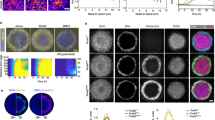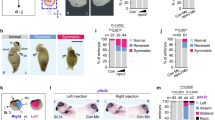Abstract
ADORSALIZING signal acts during gastrulation to change the specification of lateral mesodermal tissues from ventral (blood, mesenchyme) to more dorsal fates (muscle, heart, pronephros)1–3. This signal, from Spemann's organizer, cannot be mimicked by the mesoderm inducers activin and fibroblast growth factor2. The gene noggin is expressed in the organizer4, and could be the dorsalizing signal. Here we show that soluble noggin protein added to ventral marginal zones during gastrulation induces muscle, but that activin does not. Dorsal pattern can be partially rescued in ventralized embryos by injection of a plasmid that expresses noggin during gastrulation. The results suggest that the noggin product may be the dorsalizing signal from the organizer.
This is a preview of subscription content, access via your institution
Access options
Subscribe to this journal
Receive 51 print issues and online access
$199.00 per year
only $3.90 per issue
Buy this article
- Purchase on Springer Link
- Instant access to full article PDF
Prices may be subject to local taxes which are calculated during checkout
Similar content being viewed by others
References
Dale, L. & Slack, J. M. W. Development 100, 279–294 (1987).
Lettice, L. A. & Slack, J. M. W. Development 117, 263–272 (1993).
Stewart, R. M. & Gerhart, J. C. Development 109, 363–372 (1990).
Smith, W. C. & Harland, R. M. Cell 70, 829–840 (1992).
Hemmati-Brivanlou, A. et al. Development 110, 325–330 (1990).
Mohun, T. J., Brennan, S., Dathan, N., Fairman, S. & Gurdon, J. B. Nature 311, 716–721 (1984).
Bolce, M. E., Hemmati-Brivanlou, A., Kushner, P. D. & Harland, R. M. Development 115, 681–688 (1992).
Smith, W. C. & Harland, R. M. Cell 67, 753–765 (1991).
Sokol, S., Christian, J. L., Moon, R. T. & Melton, D. A. Cell 67, 741–752 (1991).
Christian, J. L. & Moon, R. T. Genes Dev. (in the press).
Vize, P. D., Hemmati-Brivanlou, A., Harland, R. M. & Melton, D. A. in Methods in Cell Biology. Vol 36 (eds Kay, B. K. & Peng, H. J.) 361–381 (Academic, San Diego and London, 1991).
Hemmati-Brivanlou, A. & Melton, D. A. Nature 359, 609–614 (1992).
Amaya, E., Musci, T. J. & Kirschner, M. W. Cell 66, 257–270 (1991).
Nieuwkoop, P. D. & Faber, J. Normal Table of Xenopus laevis (daudin) (North-Holland, Amsterdam, 1967).
Condie, B. G. & Harland, R. M. Development 101, 93–105 (1987).
Peng, H. B. in Methods in Cell Biology Vol. 36 (eds Kay, B. K. & Peng, H. B.) 661–662 (Academic, San Diego and London, 1991).
Dworkin-Rastl, E., Kelly, D. B. & Dworkin, M. B. J. Embryol. exp. Morph. 91, 153–168 (1986).
Krieg, P. A., Varnum, S. M., Wormington, W. M. & Melton, D. A. Devl Biol. 133, 93–100 (1989).
Kao, K. R. & Elinson, R. P. Devl Biol. 127, 64–77 (1988).
Harland, R. M. & Misher, L. Development 102, 837–852 (1988).
Author information
Authors and Affiliations
Rights and permissions
About this article
Cite this article
Smith, W., Knecht, A., Wu, M. et al. Secreted noggin protein mimics the Spemann organizer in dorsalizing Xenopus mesoderm. Nature 361, 547–549 (1993). https://doi.org/10.1038/361547a0
Received:
Accepted:
Issue Date:
DOI: https://doi.org/10.1038/361547a0
This article is cited by
-
Loss of noggin1, a classic embryonic inducer gene, in elasmobranchs
Scientific Reports (2024)
-
Deciphering and reconstitution of positional information in the human brain development
Cell Regeneration (2021)
-
Noggin4 is a long-range inhibitor of Wnt8 signalling that regulates head development in Xenopus laevis
Scientific Reports (2016)
-
Mesodermal gene expression during the embryonic and larval development of the articulate brachiopod Terebratalia transversa
EvoDevo (2015)
-
NumbL is essential for Xenopusprimary neurogenesis
BMC Developmental Biology (2013)
Comments
By submitting a comment you agree to abide by our Terms and Community Guidelines. If you find something abusive or that does not comply with our terms or guidelines please flag it as inappropriate.



